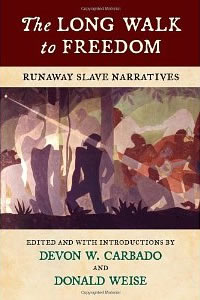Book Notes
 Devon W. Carbado and Donald Weise, editors, The Long Walk to Freedom; Runaway Slave Narratives (Boston: Beacon Press, 2012), 248pp.
Devon W. Carbado and Donald Weise, editors, The Long Walk to Freedom; Runaway Slave Narratives (Boston: Beacon Press, 2012), 248pp.
There's an extensive literature of slave narratives, but much less so of narratives written by fugitive slaves on the run. This collection of twelve first person narratives from 1815 to 1901 by runaway slaves felt like reading holocaust literature in its power to evoke the violence, sadistic torture, and exploitation of systemic evil. Several of these accounts are by famous writers whose works have remained in print — Frederick Douglass, Nat Turner, and Harriet Jacobs. Others works haven't been in print for over a hundred years.
These narratives disabuse us of any romantic notions about slave life, and of the idea that slaves were passively compliant people. Rather, they attest to the creativity, bravery, perseverance, and drastic measures that some slaves took in order to claim their human dignity. Henry Brown shipped himself in a box to the Pennsylvania Anti-Slavery Society in Philadelphia. Ellen Craft disguised herself as a white master and her husband William as "his" slave companion for a thousand-mile journey from Georgia to Pennsylvania. When Robert the Hermit finally gained his freedom he secluded himself in a cave as a hermit.
One of the most counter-intuitive facts of history is that blacks adopted the religion of their white oppressors, a religion that was often the primary means of their oppression. These fugitive narratives indict the many Christians and churches who justified slavery by appeal to their religion. This makes for very painful reading. But the stories also document how slaves were encouraged by a liberating God and gospel, and the many people who risked their own lives to help free them. There are multiple mentions of the Quakers, "that excellent class of people" who, as one slave put it, "I never feared to trust."
Beginning in 1444 and lasting over four hundred years, the European slave trade "marketed and merchandised" 40 million African people. Black history in what became America began in August of 1619 when 20 slaves disembarked from a ship in Jamestown, Virginia, and the captain traded them for "victualle." By 1860, the United States census identified four million slaves. The era of Jim Crow didn't end until the Supreme Court's ruling on Brown v. Board of Education, in 1954. This is a long, long history in the "land of the free and the home of the brave." Harriet Jacobs put it this way: "Sometimes I thought God was a compassionate Father, who would forgive my sins for the sake of my suffering. At other times, it seemed to me there was no justice or mercy in the divine government. I asked why the curse of slavery was permitted to exist, and why I had been so persecuted and wronged from youth up. These things took the shape of mystery, which is to this day not so clear to my soul as I trust it will be hereafter."


